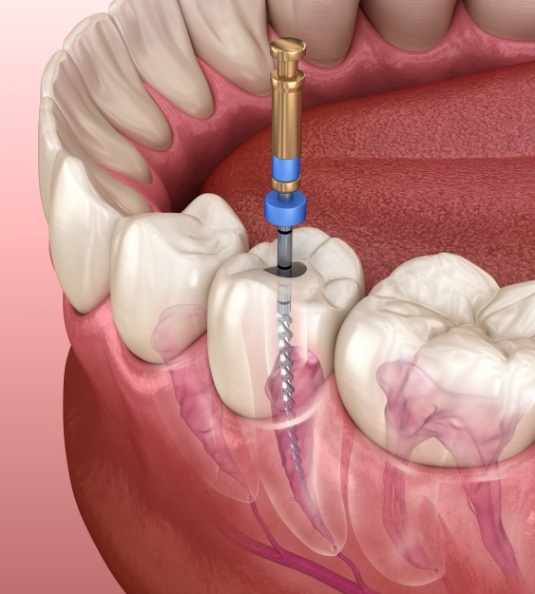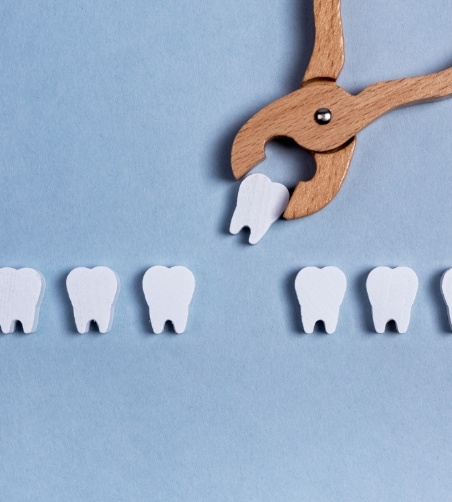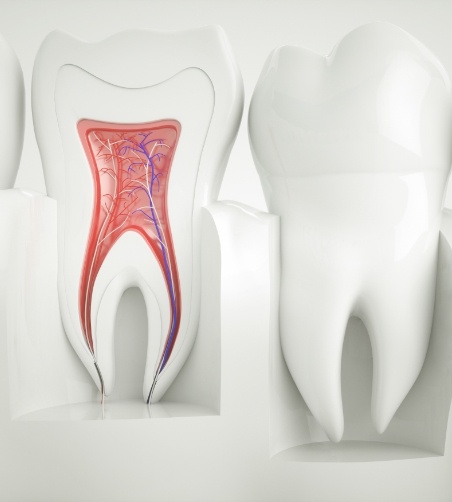Root Canal Therapy Carrollton
Addressing the Pain by Treating the Infection
When it comes to dental procedures, nothing quite strikes the same type of fear as the words root canal. While the process was known for being uncomfortable in the past, we now live in a new era of more advanced and painless dental procedures. When you visit us at DD Family Dentistry of Carrollton, you’ll finally be able to have your pain addressed, and you’ll have a fully restored tooth. To get the relief you need, contact us today to schedule a visit.
Why Choose DD Family Dentistry of Carrollton for Root Canal Therapy?
- State-of-the-Art Dental Facility & Technologies
- Natural-Looking Dental Crowns for Optimal Protection
- We Will Maximize Your Dental Insurance Benefits
What is a Root Canal?

The purpose of root canal therapy is to restore a tooth that has endured damage that can’t be addressed with a mere cavity filling. The more complex root canal procedure provides a way to remove the decayed tissue so the painful sensations that are typical with advanced decay can be alleviated. After Dr. Durga completes the first phase of the process, she’ll place a porcelain crown that will leave the tooth fully restored and functional.
Why Do I Need a Root Canal?

A traditional cavity filling is used to restore damaged enamel, the protective outer layer of the teeth. However, if bacteria growth is allowed to proceed, the decay can eventually reach the more sensitive dentin and then the pulp area, where the canals and nerve are housed. At this point, there will usually be intense bouts of pain or a continuous toothache.
By the time the problem reaches this stage, it’s of the utmost importance to give us a call so the decay can be stopped before even greater challenges arise. Therefore, your pain can be eliminated, and you can return to leading a normal life.
How Long Does the Root Canal Procedure Take?

Typically, we’ll complete the root canal process in two visits. At your first appointment, here’s what you can expect to happen:
- X-rays will be captured to pinpoint the decay.
- Numbing medication will be administered.
- An initial incision will be created in the top of the tooth to gain access to the decayed tissue.
- The infected tissue will be removed, and the area cleaned.
- A compound called gutta-percha will be added to fill the tooth.
- The tooth will be sealed.
- Bite impressions will then be taken, and a temporary crown will be placed.
After these steps are taken, your first visit will conclude. Meanwhile, we’ll send your bite impressions to a trusted lab so your final crown can be fabricated. Once it’s ready, we’ll invite you back to our office to have it placed, and you’ll leave fully restored.
Is Root Canal Therapy Painful?

As alluded to earlier, you’re fortunate to live in an era of painless dental procedures. Before the process starts, we’ll make sure the treatment area is completely numb so that you have a painless experience. If you suffer from dental procedure anxiety, we also offer sedation dentistry so your experience will be stress-free as well.
Once the initial phase of the root canal is done, though, and the medication wears off, it’s common to experience slight discomfort for the next 24-48 hours. The good news is that with an over-the-counter pain reliever, it can usually be managed. It’s also important during this period that you eat soft foods and abstain from performing vigorous oral hygiene in that part of your mouth.
If you continue to experience pain, do not hesitate to reach out to your dentist to request a visit.
Understanding the Cost of Root Canals

While dealing with a toothache, the last thing you want to worry about is the cost of root canal treatment. We want our patients to be able to receive the stress-free, accessible emergency care they deserve, which is why we’re happy to walk you through your payment options so you can get out of pain faster.
Factors That Can Affect Root Canal Cost

Because every emergency is different, it can be difficult to determine the exact cost of root canal therapy without having our team examine your mouth first. Several factors can affect the final cost of your procedure, including:
- The type and location of the tooth
- Whether a specialist needs to be brought in/the overall difficulty of the root canal
- If additional services are required, like a dental crown afterward
We’ll discuss each of these factors with you, along with a detailed cost estimate before you decide to move forward with the root canal.
Is it Cheaper to Pull My Tooth?

Some patients are tempted to extract their tooth instead of treating it, and while this may be the least expensive option, there are several important details to consider before making that decision solely based on cost. For example, if you extract a tooth, you’ll likely need to pay to have it replaced, which is an additional price factor. Or, if you choose to not replace your tooth, leaving a gap in your smile would not only make daily tasks like eating and speaking more difficult, but it could also lead to additional oral health issues down the road, like misalignment.
We strive to preserve our patients’ natural smiles at all costs and only recommend extracting a tooth if it’s damaged beyond repair or poses a threat to surrounding teeth.
Does Dental Insurance Cover Root Canals?

While most dental insurance plans cover the cost of root canal therapy, it’s typically only 50 or 80 percent covered, meaning you’ll have an out-of-pocket cost once the deductible has been met. That being said, each dental insurance plan is different, so it’s a good idea to contact your provider directly to confirm your coverage amount. Our team is happy to assist with this!
Other Options for Making Root Canal Therapy Affordable
We want you to be able to get the pain-relieving care you need without having to stress over being able to afford it. This is why we’re proud to accept dental insurance and be an in-network provider with most major PPO plans. We also offer an in-house dental savings plan and additional financing through CareCredit. With all of these avenues available to you, our team can make sure that you get a root canal without blowing your monthly budget out of the water.
Root Canal FAQs
Why do I need a root canal if my tooth doesn’t hurt?
Intense tooth pain often leads people to their dentist’s office only to discover they need a root canal. However, just because you don’t feel any tooth pain doesn’t mean that everything is fine. Your tooth’s nerves may have “died” due to trauma or infection without first feeling any discomfort, and so your tooth is no longer capable of feeling pain. Biannual dental exams are crucial to allow your dentist to check for any signs of trouble that you may not have noticed.
How long do root canals take?
Although root canal therapy can usually be completed in one appointment, it may sometimes require two sessions. During your first visit, Dr. Durga will place a temporary antibacterial medicine inside the tooth to relieve your pain. Then, you’ll return to the office at a later date to have the inside of your tooth cleaned out. In most cases, the procedure will take 30-90 minutes. Of course, the amount of time varies depending on the location of the tooth. Molars have more root canals that must be disinfected than front teeth, so root canal therapy for back teeth usually takes more time.
Are root canals safe?
Faulty research conducted almost a century ago led to persistent rumors claiming root canals are unsafe and increase your risk of various medical conditions. However, the American Association of Endodontics (AAE) has thoroughly debunked this idea. Root canal treatment performed by a qualified dentist is quite safe with a success rate of about 95 percent. As with any medical procedure, there is a very small chance of some bacteria remaining in the tooth after a root canal and causing reinfection. It’s important to play it safe, so be sure to let your dentist know if you experience intense swelling, pain, or fever in the days after your root canal.
How long does it take to recover from a root canal?
Even though the recovery time is different for everyone, most patients can return to their usual activities the day after their root canal. Keep in mind that strenuous exercise can divert blood from the site and delay the healing process. That being said, if your job requires physical labor, it’s best to take the next 2-3 days off. Your mouth will also feel sore in the first few days after your procedure. Fortunately, you can manage your discomfort by taking over-the-counter pain medication and using a cold compress. While in the healing stage, make sure you avoid chewing on the side of your mouth where the root canal occurred.

